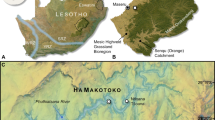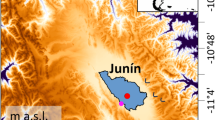Abstract
Palynology provides information about Pliocene and early Pleistocene vegetation and climate evolution inthe north-west Mediterranean area in relation to high northern latitude climatic trends. An important change occurred approximately 3.2 Myr ago with the appearance of the Mediterranean climatic rhythm (summer drought) causing the individualization of the modern Mediterranean floral elements. Quaternary-type mediterranean climatic fluctuations started approximately 2.3 Myr ago (early Glacial) causing the Mediterranean-type of vegetational organization.
This is a preview of subscription content, access via your institution
Access options
Subscribe to this journal
Receive 51 print issues and online access
$199.00 per year
only $3.90 per issue
Buy this article
- Purchase on Springer Link
- Instant access to full article PDF
Prices may be subject to local taxes which are calculated during checkout
Similar content being viewed by others
References
Axelrod, D. I. Mediterranean Type Ecosystems, Origin and Structure (eds Castri, F. Di & Mooney, H. A.) 225–227 (Springer, Berlin, 1972).
Nahal, I. Ecosystems of the World (ed. Castri, F. Di.) 63–86 (Elsevier, Amsterdam, 1981).
Quézel, P. & Shevok, J. Ecol. Médit. 8, 389–408 (1982).
Ciaranfi, N. & Cita, M. B. Init. Rep. DSDP 13, 1387–1399 (1973).
Thunnel, R. C. Sed. Geol. 23, 67–79 (1979).
Keigwin, Jr, L. D. & Thunnel, R. C. Nature 282, 294–296 (1979).
Chamley, H. Bull. Gr. fr. Argiles 27, 97–137 (1975).
Pons, A. Ann. Sci. Nat. 5, 499–722 (1964).
Bertoldi, R. Atti Acad. Naz. Lincei 62, 547–555 (1977).
Bertolani-Marchetti, D., L'Ateneo Parmense 11, 467–485 (1975).
Roiron, P. Paléobiol. cont. 12, 27–42 (1981).
Vernet, J.-L. Paléobiol. cont. 12, 43–51 (1981).
Cravatte, J. & Suc, J.-P. Pollen et Spores 23, 247–258 (1981).
Suc, J.-P. & Cravatte, J. Paléobiol. cont. 13, 1–31 (1982).
Cravatte, J., Dufaure, P., Prim, M. & Rouaix, S. Notes Mém. Comp. fr. Pétroles 11, 209–274 (1974).
Cita, M. B. & Ryan, W. B. F. Init. Rep. DSDP 13, 1405–1415 (1973).
Suc, J.-P. Paléobiol. cont. 12, 7–26 (1981).
Suc, J.-P. Pollen Spores 20, 497–512 (1978).
Baggioni, M., Suc, J.-P. & Vernet, J.-L. Geobios 14, 229–237 (1981).
Michaux, J. Bull. Ass. fr. ét. Quaternaire 36, 24–40 (1973).
Ildefonse, J.-P., Bellon, H., Pantaloni, A. & Philippet, J.-C. Earth planet. Sci. Lett. 14, 249–254 (1972).
Lindsay, E. H., Opdyke, N. D. & Johnson, N. M. Nature 287, 135–138 (1980).
Sémah, F. & Biquand, D. Paléobiol. cont. 12, 167–173 (1981).
Suc, J.-P. C. r. hebd Séanc. Acad. Sci., Paris 294, 1003–1008 (1982).
Wang, Chi-Wu. The Forests of China 5, 313 (Maria Moors Cabot Foundation, Cambridge USA, 1961).
Michaux, J., Suc, J.-P. & Vernet, J.-L. Rev. Palaeobot. Palynol. 27, 185–191 (1979).
Quézel, P., Barbero, M., Bonin, G. & Loisel, R. Nat. Monsp. 89–100 (1980).
Bessedik, M. C. r. hebd. Séanc. Acad. Sci., Paris 293, 469–472 (1981).
Barrière, J. Bull. Ass. fr. ét. Quaternaire 8, 142–144 (1971).
Zohary, M. Geobotanical Foundations of the Middle East (Fisher, Stuttgart, 1973).
Suc, J.-P. & Zagwijn, W. H. Boreas 12, 153–166 (1983).
Emberger, L. & Sabéti, A., Nat. Monsp. Bot. 14, 55–61 (1962).
Juliá Bruguès, R. & Suc, J.-P. Geobios 13, 5–19 (1980).
Hammen, T. van der, Wijmstra, T. A. & Zagwijn, W. H. The Late Cenozoic Glacial Ages, (ed. Turekian, K. K.) 391–424 (Yale University Press, New Haven, 1971).
Cita, M. B., Chierici, M. A., Ciampo, G., Zei, M., D'Onofrio, S., Ryan, W. B. F. & Scoriziello, R. Init. Rep. DSDP 12, 1263–1339 (1973).
Zagwijn, W. H. Meded. Geol. Sticht C3, 1–78 (1960).
Zagwijn, W. H. Boreas 3, 75–97 (1974).
Berggren, W. A. Init. Rep. DSDP 12, 953–963 (1972).
Shakleton, N. J. & Opdyke, N. D. Nature 270, 216–219 (1977).
Shackleton, N. J. & Cita, M. B. Init. Rep. DSDP 47, 433–445 (1979).
Keigwin, Jr, L. D. Science 217, 350–353 (1982).
Author information
Authors and Affiliations
Rights and permissions
About this article
Cite this article
Suc, JP. Origin and evolution of the Mediterranean vegetation and climate in Europe. Nature 307, 429–432 (1984). https://doi.org/10.1038/307429a0
Received:
Accepted:
Issue Date:
DOI: https://doi.org/10.1038/307429a0
This article is cited by
-
Dissecting the continuum and unravelling the phylogeographic knot of plastid DNA in European white oaks (Quercus sect. Quercus): ancient signatures and multiple diversity reservoirs
European Journal of Forest Research (2024)
-
Timing of fire during summer determines seed germination in Mediterranean Cistaceae
Fire Ecology (2023)
-
Biogeography of Rhaponticoides, an Irano-Turanian element in the Mediterranean flora
Scientific Reports (2022)
-
Plant phylogeography of the Balkan Peninsula: spatiotemporal patterns and processes
Plant Systematics and Evolution (2022)
-
The late Miocene Beli Breg Basin (Bulgaria): palaeoecology and climate reconstructions based on pollen data
Palaeobiodiversity and Palaeoenvironments (2021)
Comments
By submitting a comment you agree to abide by our Terms and Community Guidelines. If you find something abusive or that does not comply with our terms or guidelines please flag it as inappropriate.



